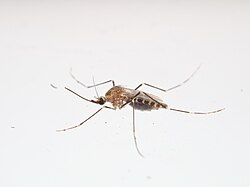Biology:Aedes epactius
From HandWiki
Short description: Species of fly
| Aedes epactius | |
|---|---|

| |
| Scientific classification | |
| Domain: | Eukaryota |
| Kingdom: | Animalia |
| Phylum: | Arthropoda |
| Class: | Insecta |
| Order: | Diptera |
| Family: | Culicidae |
| Genus: | Aedes |
| Subgenus: | Ochlerotatus |
| Species: | A. epactius
|
| Binomial name | |
| Aedes epactius Dyer & Knab, 1908
| |
| Synonyms[1] | |
| |
Aedes epactius is a species of mosquito (Culicidae) native to North America.[2][3][4] Some mosquitoes in North America, such as Aedes albopictus and Aedes aegypti have a similar scutellum pattern.[citation needed]
Diet
Like other mosquito species, female Aedes epactius take blood meal to develop their eggs. Apart from blood-feeding, they feed on nectar and other sweet plant juices.[5]
References
- ↑ https://academic.oup.com/jme/article/49/6/1244/963640
- ↑ Ostrum, Erik M.; Mutebi, John-Paul (March 2019). "New county records of Aedes aegypti and Aedes epactius in Colorado". Journal of the American Mosquito Control Association 35 (1): 47–50. doi:10.2987/18-6774.1. PMID 31442179.
- ↑ Stiles, Brad; Dunn, Peter E.; Paschke, J. D. (1983-03-01). "Histopathology of a nuclear polyhedrosis infection in Aedes epactius with observations in four additional mosquito species" (in en). Journal of Invertebrate Pathology 41 (2): 191–202. doi:10.1016/0022-2011(83)90219-7. PMID 6132948. https://dx.doi.org/10.1016%2F0022-2011%2883%2990219-7. Retrieved 2020-08-20.
- ↑ J.l, Hardy; L, Rosen; L.d, Kramer; S.b, Presser; D.a, Shroyer; M.j, Turell (1980). "Effect of rearing temperature on transovarial transmission of St. Louis encephalitis virus in mosquitoes [Aedes albopictus and Aedes epactius."] (in English). Food and Agriculture Organization of the United Nations. https://agris.fao.org/agris-search/search.do?recordID=US19820748846.
- ↑ Lozano-Fuentes S (2014). "Aedes (Ochlerotatus) epactius Along an Elevation and Climate Gradient in Veracruz and Puebla States, México". Journal of Medical Entomology 49 (6): 1244–53. doi:10.1603/ME12067. PMID 23270151.
Wikidata ☰ Q9584575 entry
 |

